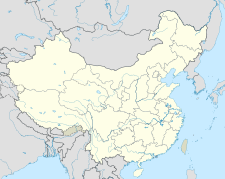| Imparavis Temporal range: Early Cretaceous (Aptian), 120 Ma PreꞒ Ꞓ O S D C P T J K Pg N ↓ | |
|---|---|
| Scientific classification | |
| Domain: | Eukaryota |
| Kingdom: | Animalia |
| Phylum: | Chordata |
| Clade: | Dinosauria |
| Clade: | Saurischia |
| Clade: | Theropoda |
| Clade: | Avialae |
| Clade: | †Enantiornithes |
| Genus: | †Imparavis |
| Species: | †I. attenboroughi |
| Binomial name | |
| †Imparavis attenboroughi Wang et al., 2024 | |
Imparavis (meaning "odd bird") is an extinct genus of enantiornithean birds from the Early Cretaceous (Aptian-aged) Jiufotang Formation of Liaoning Province, China. The genus contains a single species, I. attenboroughi, known from a well-preserved skeleton.
Discovery and naming

The Imparavis holotype specimen, STM11-176, was discovered in sediments of the Jiufotang Formation near Toudaoyingzi village in Jianchang County, Liaoning Province, China. The holotype is preserved on a single slab, consisting of an articulated, nearly complete specimen, preserved in ventral view. It is missing part of the vertebral column and most of the gastralia. Faint feather traces are visible around parts of the skeleton.
In 2024, Wang et al. described Imparavis attenboroughi as a new genus and species of enantiornithean bird based on these fossil remains. The generic name, "Imparavis", combines the Latin words "impar", meaning "odd", and "avis", meaning "bird". The specific name, "attenboroughi", honors David Attenborough and his work with natural history presentation and wildlife preservation.
Classification
In their phylogenetic analyses, Wang et al. (2024) recovered Imparavis as a member of the Enantiornithes, as the sister taxon to Yuornis in a clade of edentulous genera also containing Gobipteryx. A close relationship between Gobipteryx and Yuornis was also supported in the scientific description of the latter. The results of the analyses of Wang et al. are shown in the cladogram below, with toothless taxa highlighted.
| |||||||||||||||||||||||||||||||||||||||||||||||||||||||||||||||||||||||||||||||||||||||||||||||||||||||||||||||||||||||||||||||||||||||||||||||||||||||||||||||||||
References
- ^ Wang, Xiaoli; Clark, Alexander D.; O'Connor, Jingmai K.; Zhang, Xiangyu; Wang, Xing; Zheng, Xiaoting; Zhou, Zhonghe (2024-02-27). "First Edentulous Enantiornithine (Aves: Ornithothoraces) from the Lower Cretaceous Jehol Avifauna". Cretaceous Research. 159 (in press): 105867. Bibcode:2024CrRes.15905867W. doi:10.1016/j.cretres.2024.105867. ISSN 0195-6671.
- Xu, Li; Buffetaut, Eric; O’Connor, Jingmai; Zhang, Xingliao; Jia, Songhai; Zhang, Jiming; Chang, Huali; Tong, Haiyan (November 2021). "A new, remarkably preserved, enantiornithine bird from the Upper Cretaceous Qiupa Formation of Henan (central China) and convergent evolution between enantiornithines and modern birds". Geological Magazine. 158 (11): 2087–2094. Bibcode:2021GeoM..158.2087X. doi:10.1017/S0016756821000807. ISSN 0016-7568. S2CID 238748196.

